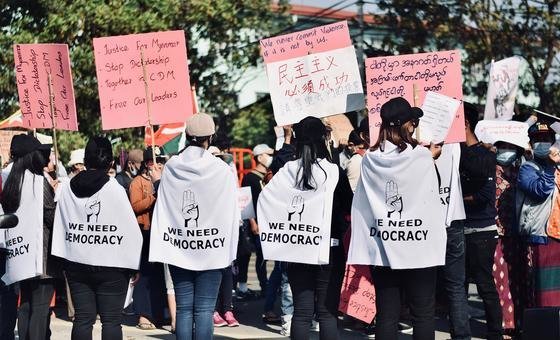
“Continuous” violence, including the killing, arbitrary arrest, torture and enforced disappearance of opponents in Myanmar between 1 February 2022 and 31 January 2023, have left the country’s people desperate for outside help, OHCHR’s James Rodehaver said, unveiling the Office’s latest report on the crisis.
“Despite all the challenges that they face, so far there has been so far no break in the will of Myanmar’s people to oppose this coup and to continue searching for their human rights and democratic future.”
Tatmadaw control
According to the UN rights office report, around 3,000 civilians have been killed since the coup. A full 30 per cent are believed to have died in custody.
Violence rose sharply last year – especially in northwest and southeast Myanmar – which has left the military “actively fighting” on 14 different fronts. “(It is) one of the reasons why they are stretched so thin and why they’re having to rely on airstrikes and heavy weaponry,” said Mr. Rodehaver, who heads OHCHR’s Myanmar team. “It does not paint a picture of them being in control.”
Rights chief’s appeal
In a call for “urgent, concrete action” to end the crisis, UN High Commissioner for Human Rights, Volker Türk, backed calls for an immediate halt to the violence, the release of all those arbitrarily detained, accountability and unhindered humanitarian access.
The UN rights chief added: “Two years after the military launched a coup, the generals have embarked on a scorched earth policy in an attempt to stamp out opposition. Tragically, regional and global efforts for peace and restraint have largely fallen on deaf ears…Urgent, concrete action is needed to end this festering catastrophe.”
Airstrike horror
Among the many documented airstrikes on civilians, OHCHR’s report details how four helicopters opened fire on a school killing at least six children and injuring nine others, on 16 September 2022, in Let Yet Kone village, Tabayin Township, Sagaing.
“After some 60 soldiers deployed from helicopters to the ground, they reportedly raided the village, executing a school technician and five villagers before arresting wounded children and teachers,” OHCHR spokesperson, Ravina Shamdasani, told journalists in Geneva.
In another incident, on 20 October last year, an airstrike against a hospital in Man Yu Gyi village, Banmauk Township, Sagaing, killed one woman and injured five others. The OHCHR report noted that the hospital had been inaugurated a day earlier and that the victims were all volunteers.
Death by four cuts
OHCHR’s Ms. Shamdasani explained that military employs a “four cuts” approach, involving indiscriminate airstrikes and artillery shelling, razing villages to the ground to displace civilian populations and the denial of humanitarian access. The strategic aim is to cut off non-State organized armed groups and other anti-military armed elements from access to food, financing, intelligence and recruits.
“Consistent with their modus operandi documented over decades, including in Kachin in 2011 and Rakhine in 2017, UN reports indicated that nearly 39,000 houses nationwide have been burnt or destroyed in military operations since February 2022, representing a more than 1,000-fold increase compared to 2021,” the OHCHR spokesperson said.
Sagaing was the most affected region, accounting for over 25,500 homes. In an incident on 1 May 2022 in Ah Shey See, Kale Township, Sagaing, satellite images suggest the burning of almost the entire village, with 621 structures destroyed.
Furthermore, satellite imagery coupled with interview reports suggest that between 16 and 28 September in Taze Township, Sagaing, the military destroyed 458 houses and damaged another 319 across eight villages during a series of raids and attacks.
Political detainees’ plight
The UN rights office report also noted that there are now also nearly 20,000 political prisoners in Myanmar. Some 16,000 remain in detention but their whereabouts remain unclear.
“Many of those people, we know that they were arrested but we have no idea where they are, and that includes their families,” said OHCHR’s Mr. Rodehaver. “Unfortunately, no-one is given access to the detention centres, including many humanitarian groups.”
He added: “The people that we do get hold of – who either have been able to contact their relatives in detention, or when detainees are released – their stories are very grim, either about the conditions they are kept in and in terms of the use of torture.”
Because OHCHR does not have access to Myanmar, the report’s findings are based on over 96 interviews and meetings with victims, survivors and corroborated by satellite imagery, verified multimedia files, and credible open-source information as well as regular collaboration, data and information exchanges within the UN system.
“Figures of casualties likely represent an underestimation of the reality on the ground,” it noted.



